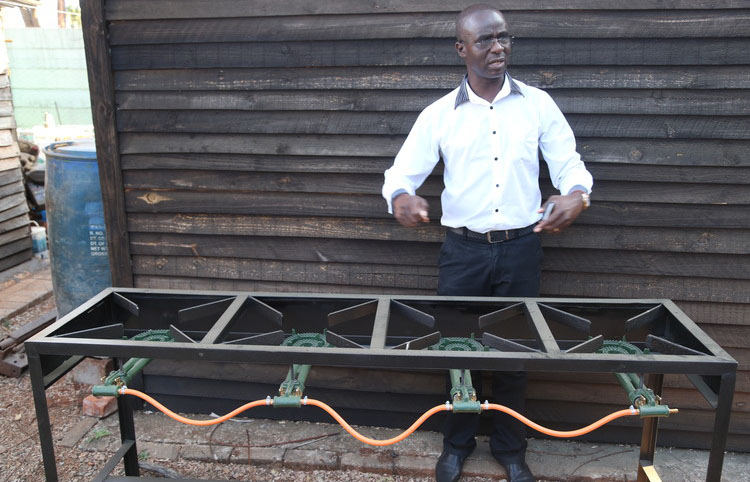
The Sunday Mail

A 20-cubic metre biogas digester, probably the first one of such a size to be built in Mbire district at Chitsungo Mission Hospital, is likely to impact the district in more than one way.
The hospital, the only referral one in the district, caters for a population of around 90 000, with most of the cases coming from the 12 clinics in Mbire.
Being a malaria-prone area, at any given time the hospital has over a hundred patients in admission, which makes the demand for cooking fuel an inevitable requirement.
“As it stands,” explained Wellington Makuvatsine, the hospital’s administrator, “We use between 20 and 30 truckloads of firewood per year. In as much as we are encouraged to use dried trees for firewood, the demand for energy is such that we cannot afford to wait for trees to die naturally. So we end up cutting trees for firewood so that we keep our patients on a healthy diet.”
The massive deforestation that the hospital inadvertently engages itself in, in a bid to help the community that it serves, is about to come to an end, thanks to a green energy project that the health institution has embarked on with some help from Carbon Green Africa.
 Mr Charles Ndondo, of Carbon Green Africa, shows off the four-plate gas stove that will be used by Chitsungo Mission Hospital’s biogas digester project
Mr Charles Ndondo, of Carbon Green Africa, shows off the four-plate gas stove that will be used by Chitsungo Mission Hospital’s biogas digester projectThe latter is working in a technical partnership with Sustainable Agricultural Technology (SAT).
The partnership has seen the construction of the 20-cubic metre biogas digester, set for completion and commissioning in the coming fortnight.
“The digester has many advantages but the most important being that the hospital will no longer have to rely on firewood for cooking energy,” explained Makuvatsine.
“Second, the digester will feed on animal waste, this being cow dung, pig or chicken manure. On a daily basis we will need two drums, or 150 kg, of such waste.
‘‘This means that the community will get an incentive for collecting animal waste and there will be an extra job created as the hospital will have to employ someone who will have to go around collecting the waste from the villages surrounding the hospital.
“Then the residue that comes from the anaerobic decomposition of the waste can still be used as manure, which in this case will be weed-free because all the weed seed in the waste would have been decomposed.”
In the long term, for the biogas digester to run effectively, the hospital intends to run a piggery and chicken project so that there is a ready supply of animal waste.
“By running these projects, besides supplying animal waste, we will in a way mitigate our food budget, as we will able to supply the hospital kitchen with a variety of food options, all home-grown,” further explained Father Samuel Nyadzayo, whose Chinhoi Diocese of the Catholic Church runs the hospital.
Makuvatsine, visibly ecstatic about the biogas digester project, said the other benefit to be derived will be the access to cheaper medication to the community.
“We are going to save big on our electricity consumption because the 5 000kg of gas that this digester will produce, will, apart from cooking, be used for lighting. Naturally the savings that the hospital will realise will ensure that health delivery to the community will then be delivered at a much lower cost.”
The other benefit, Makuvatsine oozed, will be the direct impact the digester will have on their expanded programme for immunisation.
“We have vaccines for the programme that need to be under refridgeration all the time and since we already have gas refridgerators, the digester will ensure that we have a constant supply of gas.”
Arthur Kupara, who is overseeing the construction of the digester on behalf of Sustainable Agricultural Technologies, said in the short-term they will use the Chitsungo biogas digester as a knowledge centre as they have intentions to roll out similar projects in the local community.
“At household level, a six-cubic metre digester will be ideal and we would love to see the local community replicating this digester in their homes. The net effect that this will have on the forests will be enormous as a lot of trees will be saved.
“As previously stated, the residue can still be used as manure, but this time in a cleaner state as the manure will be weed-free.”
The hospital is hoping that with the revival of Arda Mushumbi, which is using exclusively organic farming methods, there will be a ready market for their “treated” manure.
“At the moment the farm is getting pig manure all the way from Harare, yet we are only 20km away from them. So if the digester is fully functional, we will have a ready market for our manure in the form of Arda, generating further income for the hospital and lessening the cost of hospitalisation on the patient.”
A biogas digester is an enclosed structure, more like the domestic gas cylinder, which allows methane, hydrogen and carbon to be produced by bacteria in an anaerobic environment. The structure is made of ordinary farm bricks, cement, gas pipes and valves.



